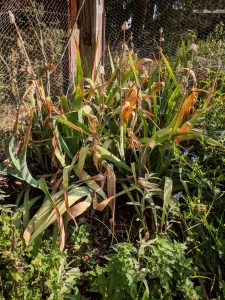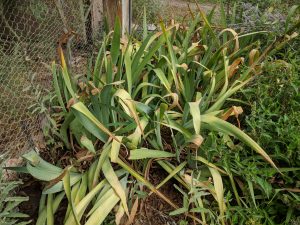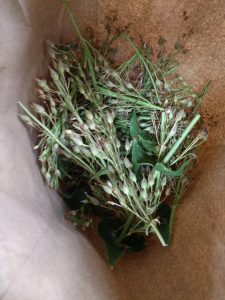Summer is here in the west in a big way. We are just coming off of one of the largest heat waves ever recorded, and while temperatures are down they are not done. Its hot. Depending on where you live your gardens may have suffered. In the East Hurricanes are starting and extreme rains are occurring. I have images of bent over palm trees in Florida. No matter the season, plants respond with their own growth stages providing they are not blow away or burnt up by raging wildfires. Here in Arizona we have had moderately hot weather in my location but the garden is surviving with irrigation. My Iris plants remind me that it is long past time to deadhead and remove spent flower stalks. Deadheading is second nature to most gardeners and other than making the garden look better, you may not realize why you have or have not adopted this common garden practice.
Deadheading involves removing the spent flowers or inflorescences have withered. Sometimes pruning back to a lower leaf or adventitious bud in the case of roses, or completely removing flower stalks in the case of German Iris is required. The immediate result is a neater looking garden and an emphasis on remaining blooms. When the dead flowers are gone the remaining flowers look better the garden is refreshed. Depending on the plant there can be other benefits if deadheading is done consistently and is well timed.

We grow many kinds of plants in our gardens and deadheading has varied physiological impact depending on the subject being pruned. Properly timed, deadheading can extend the bloom of some plants for example Calendula. However, Calendula produces lots of flowers and removing spent flowers can become an enduring task if you have a lot of Calendulas. Deadheading some garden plants seems pointless such as impatiens which just regenerates flowers on its own. Deadheading soon after a flower passes prevents the plant from investing energy in seed development. If the plant has a long enough bloom cycle, so that energy can be put into other flowers then trimming back the flowering stem stems that are destined to fruit production often releases other buds to grow more flowers. Since photosynthate (sugars) flows in plants on a source-sink model, taking away the “sink” or developing fruit allows energy to be used for growth elsewhere in the plant. The trick is to remove spent flowers soon because seed begins to form immediately after flowering and the plant will rapidly allocate its energy to reproduction once the flowers are pollinated.

Not all garden plants respond to deadheading–the number of flowers some plants present is genetically regulated and dead flower removal does not promote more flowering (many bulbs produce only one set of flowers). Other garden plants will re-bloom if given a chance, and with deadheading (no matter what the flowering habit) the garden will look better without the dead flowers. Some bulbs can be deadheaded to prevent seed formation so that the energy is put back into the bulb or bulblets for next year’s display. Many roses will re-bloom after deadheading. This is not a wild-type characteristic of roses but a quality that has been selected for after years of plant breeding.
Deadheading can also be an excellent method of excluding diseases. Botrytis on rose blossoms and petal blight on Camellia are both controlled to some degree by removing infected blooms as soon as they are observed and disposing of them away from the garden.

Sometimes deadheading results in seed collection. Left too long, some plants go to seed but have not yet released their seed. If you want to save seed for propagation, strategic deadheading will allow you to collect seed while redirecting the plants growth patterns for more vegetation or more flower shoots. It is also helpful with our more ruderal garden friends to remove flower stalks to prevent their reproduction and taking over of smaller garden spaces that endure frequent cultivation or soil disturbance. Some plants are desirable but their progeny are a bother….
Question! My wife is an ornithologist and encourages me not to deadhead so the seeds can go to birds. (https://www.audubon.org/news/how-make-your-yard-bird-friendly-0) Is that ok too?
This is fine and a good idea. How you allocate your garden resources is up to you. If you want to grow seeds for visiting birds that’s great. Deahead them when the seeds are all gone…